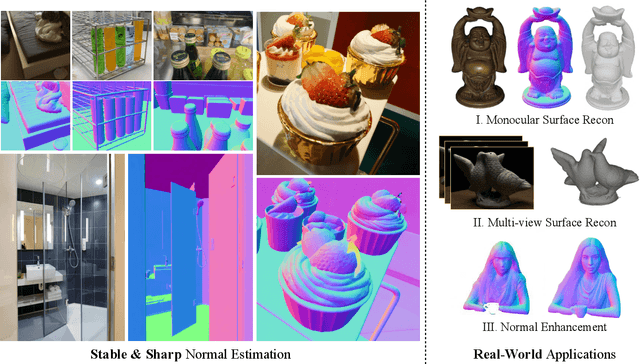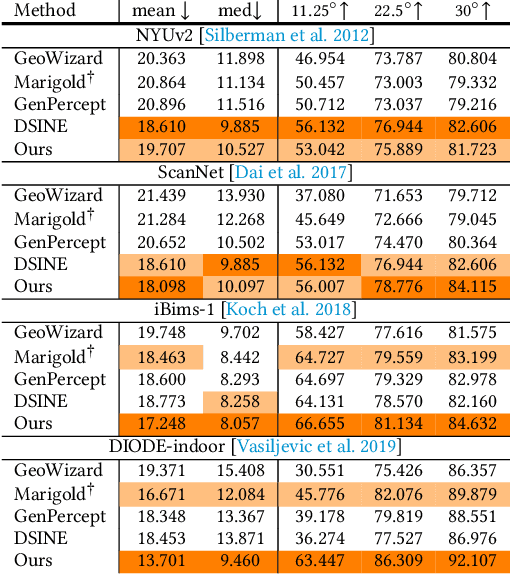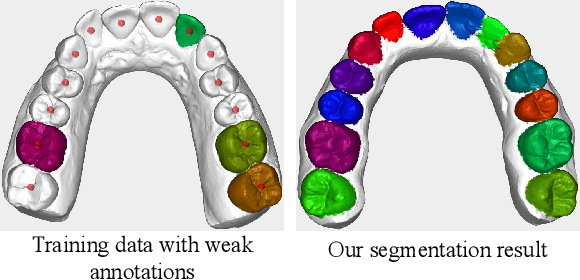Chongjie Ye
Hi3DGen: High-fidelity 3D Geometry Generation from Images via Normal Bridging
Mar 31, 2025Abstract:With the growing demand for high-fidelity 3D models from 2D images, existing methods still face significant challenges in accurately reproducing fine-grained geometric details due to limitations in domain gaps and inherent ambiguities in RGB images. To address these issues, we propose Hi3DGen, a novel framework for generating high-fidelity 3D geometry from images via normal bridging. Hi3DGen consists of three key components: (1) an image-to-normal estimator that decouples the low-high frequency image pattern with noise injection and dual-stream training to achieve generalizable, stable, and sharp estimation; (2) a normal-to-geometry learning approach that uses normal-regularized latent diffusion learning to enhance 3D geometry generation fidelity; and (3) a 3D data synthesis pipeline that constructs a high-quality dataset to support training. Extensive experiments demonstrate the effectiveness and superiority of our framework in generating rich geometric details, outperforming state-of-the-art methods in terms of fidelity. Our work provides a new direction for high-fidelity 3D geometry generation from images by leveraging normal maps as an intermediate representation.
OccluGaussian: Occlusion-Aware Gaussian Splatting for Large Scene Reconstruction and Rendering
Mar 20, 2025Abstract:In large-scale scene reconstruction using 3D Gaussian splatting, it is common to partition the scene into multiple smaller regions and reconstruct them individually. However, existing division methods are occlusion-agnostic, meaning that each region may contain areas with severe occlusions. As a result, the cameras within those regions are less correlated, leading to a low average contribution to the overall reconstruction. In this paper, we propose an occlusion-aware scene division strategy that clusters training cameras based on their positions and co-visibilities to acquire multiple regions. Cameras in such regions exhibit stronger correlations and a higher average contribution, facilitating high-quality scene reconstruction. We further propose a region-based rendering technique to accelerate large scene rendering, which culls Gaussians invisible to the region where the viewpoint is located. Such a technique significantly speeds up the rendering without compromising quality. Extensive experiments on multiple large scenes show that our method achieves superior reconstruction results with faster rendering speed compared to existing state-of-the-art approaches. Project page: https://occlugaussian.github.io.
StableNormal: Reducing Diffusion Variance for Stable and Sharp Normal
Jun 24, 2024



Abstract:This work addresses the challenge of high-quality surface normal estimation from monocular colored inputs (i.e., images and videos), a field which has recently been revolutionized by repurposing diffusion priors. However, previous attempts still struggle with stochastic inference, conflicting with the deterministic nature of the Image2Normal task, and costly ensembling step, which slows down the estimation process. Our method, StableNormal, mitigates the stochasticity of the diffusion process by reducing inference variance, thus producing "Stable-and-Sharp" normal estimates without any additional ensembling process. StableNormal works robustly under challenging imaging conditions, such as extreme lighting, blurring, and low quality. It is also robust against transparent and reflective surfaces, as well as cluttered scenes with numerous objects. Specifically, StableNormal employs a coarse-to-fine strategy, which starts with a one-step normal estimator (YOSO) to derive an initial normal guess, that is relatively coarse but reliable, then followed by a semantic-guided refinement process (SG-DRN) that refines the normals to recover geometric details. The effectiveness of StableNormal is demonstrated through competitive performance in standard datasets such as DIODE-indoor, iBims, ScannetV2 and NYUv2, and also in various downstream tasks, such as surface reconstruction and normal enhancement. These results evidence that StableNormal retains both the "stability" and "sharpness" for accurate normal estimation. StableNormal represents a baby attempt to repurpose diffusion priors for deterministic estimation. To democratize this, code and models have been publicly available in hf.co/Stable-X
GauStudio: A Modular Framework for 3D Gaussian Splatting and Beyond
Mar 28, 2024Abstract:We present GauStudio, a novel modular framework for modeling 3D Gaussian Splatting (3DGS) to provide standardized, plug-and-play components for users to easily customize and implement a 3DGS pipeline. Supported by our framework, we propose a hybrid Gaussian representation with foreground and skyball background models. Experiments demonstrate this representation reduces artifacts in unbounded outdoor scenes and improves novel view synthesis. Finally, we propose Gaussian Splatting Surface Reconstruction (GauS), a novel render-then-fuse approach for high-fidelity mesh reconstruction from 3DGS inputs without fine-tuning. Overall, our GauStudio framework, hybrid representation, and GauS approach enhance 3DGS modeling and rendering capabilities, enabling higher-quality novel view synthesis and surface reconstruction.
LASA: Instance Reconstruction from Real Scans using A Large-scale Aligned Shape Annotation Dataset
Dec 19, 2023Abstract:Instance shape reconstruction from a 3D scene involves recovering the full geometries of multiple objects at the semantic instance level. Many methods leverage data-driven learning due to the intricacies of scene complexity and significant indoor occlusions. Training these methods often requires a large-scale, high-quality dataset with aligned and paired shape annotations with real-world scans. Existing datasets are either synthetic or misaligned, restricting the performance of data-driven methods on real data. To this end, we introduce LASA, a Large-scale Aligned Shape Annotation Dataset comprising 10,412 high-quality CAD annotations aligned with 920 real-world scene scans from ArkitScenes, created manually by professional artists. On this top, we propose a novel Diffusion-based Cross-Modal Shape Reconstruction (DisCo) method. It is empowered by a hybrid feature aggregation design to fuse multi-modal inputs and recover high-fidelity object geometries. Besides, we present an Occupancy-Guided 3D Object Detection (OccGOD) method and demonstrate that our shape annotations provide scene occupancy clues that can further improve 3D object detection. Supported by LASA, extensive experiments show that our methods achieve state-of-the-art performance in both instance-level scene reconstruction and 3D object detection tasks.
MVImgNet: A Large-scale Dataset of Multi-view Images
Mar 10, 2023



Abstract:Being data-driven is one of the most iconic properties of deep learning algorithms. The birth of ImageNet drives a remarkable trend of "learning from large-scale data" in computer vision. Pretraining on ImageNet to obtain rich universal representations has been manifested to benefit various 2D visual tasks, and becomes a standard in 2D vision. However, due to the laborious collection of real-world 3D data, there is yet no generic dataset serving as a counterpart of ImageNet in 3D vision, thus how such a dataset can impact the 3D community is unraveled. To remedy this defect, we introduce MVImgNet, a large-scale dataset of multi-view images, which is highly convenient to gain by shooting videos of real-world objects in human daily life. It contains 6.5 million frames from 219,188 videos crossing objects from 238 classes, with rich annotations of object masks, camera parameters, and point clouds. The multi-view attribute endows our dataset with 3D-aware signals, making it a soft bridge between 2D and 3D vision. We conduct pilot studies for probing the potential of MVImgNet on a variety of 3D and 2D visual tasks, including radiance field reconstruction, multi-view stereo, and view-consistent image understanding, where MVImgNet demonstrates promising performance, remaining lots of possibilities for future explorations. Besides, via dense reconstruction on MVImgNet, a 3D object point cloud dataset is derived, called MVPNet, covering 87,200 samples from 150 categories, with the class label on each point cloud. Experiments show that MVPNet can benefit the real-world 3D object classification while posing new challenges to point cloud understanding. MVImgNet and MVPNet will be publicly available, hoping to inspire the broader vision community.
Chat-to-Design: AI Assisted Personalized Fashion Design
Jul 03, 2022


Abstract:In this demo, we present Chat-to-Design, a new multimodal interaction system for personalized fashion design. Compared to classic systems that recommend apparel based on keywords, Chat-to-Design enables users to design clothes in two steps: 1) coarse-grained selection via conversation and 2) fine-grained editing via an interactive interface. It encompasses three sub-systems to deliver an immersive user experience: A conversation system empowered by natural language understanding to accept users' requests and manages dialogs; A multimodal fashion retrieval system empowered by a large-scale pretrained language-image network to retrieve requested apparel; A fashion design system empowered by emerging generative techniques to edit attributes of retrieved clothes.
DArch: Dental Arch Prior-assisted 3D Tooth Instance Segmentation
Apr 25, 2022



Abstract:Automatic tooth instance segmentation on 3D dental models is a fundamental task for computer-aided orthodontic treatments. Existing learning-based methods rely heavily on expensive point-wise annotations. To alleviate this problem, we are the first to explore a low-cost annotation way for 3D tooth instance segmentation, i.e., labeling all tooth centroids and only a few teeth for each dental model. Regarding the challenge when only weak annotation is provided, we present a dental arch prior-assisted 3D tooth segmentation method, namely DArch. Our DArch consists of two stages, including tooth centroid detection and tooth instance segmentation. Accurately detecting the tooth centroids can help locate the individual tooth, thus benefiting the segmentation. Thus, our DArch proposes to leverage the dental arch prior to assist the detection. Specifically, we firstly propose a coarse-to-fine method to estimate the dental arch, in which the dental arch is initially generated by Bezier curve regression, and then a graph-based convolutional network (GCN) is trained to refine it. With the estimated dental arch, we then propose a novel Arch-aware Point Sampling (APS) method to assist the tooth centroid proposal generation. Meantime, a segmentor is independently trained using a patch-based training strategy, aiming to segment a tooth instance from a 3D patch centered at the tooth centroid. Experimental results on $4,773$ dental models have shown our DArch can accurately segment each tooth of a dental model, and its performance is superior to the state-of-the-art methods.
 Add to Chrome
Add to Chrome Add to Firefox
Add to Firefox Add to Edge
Add to Edge